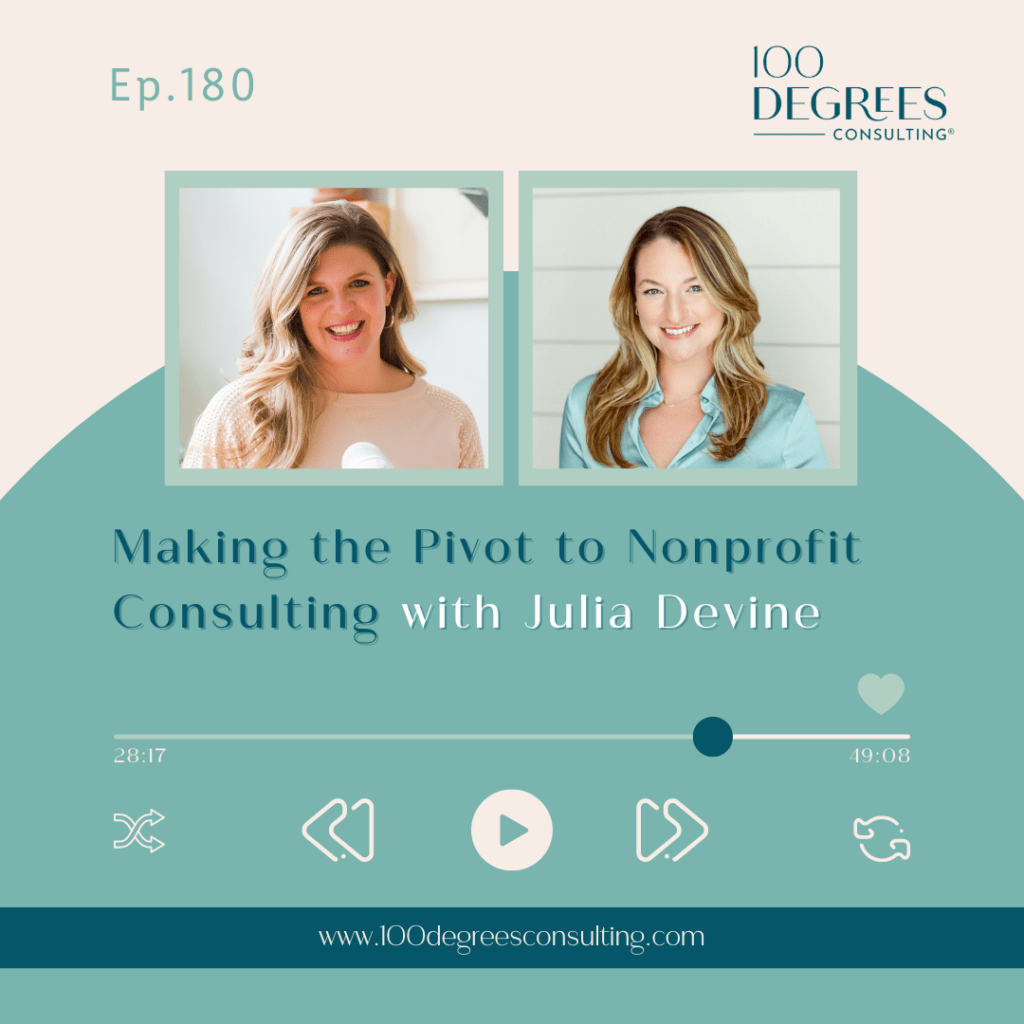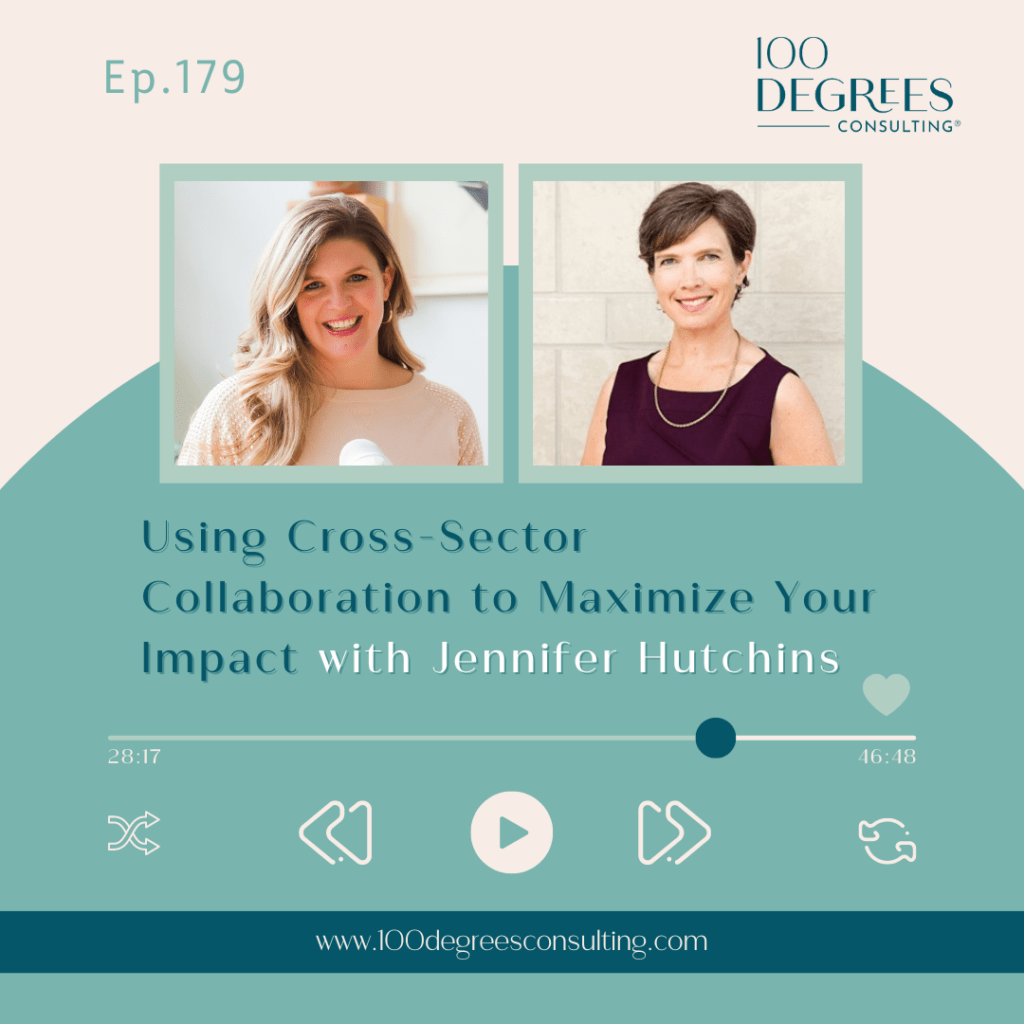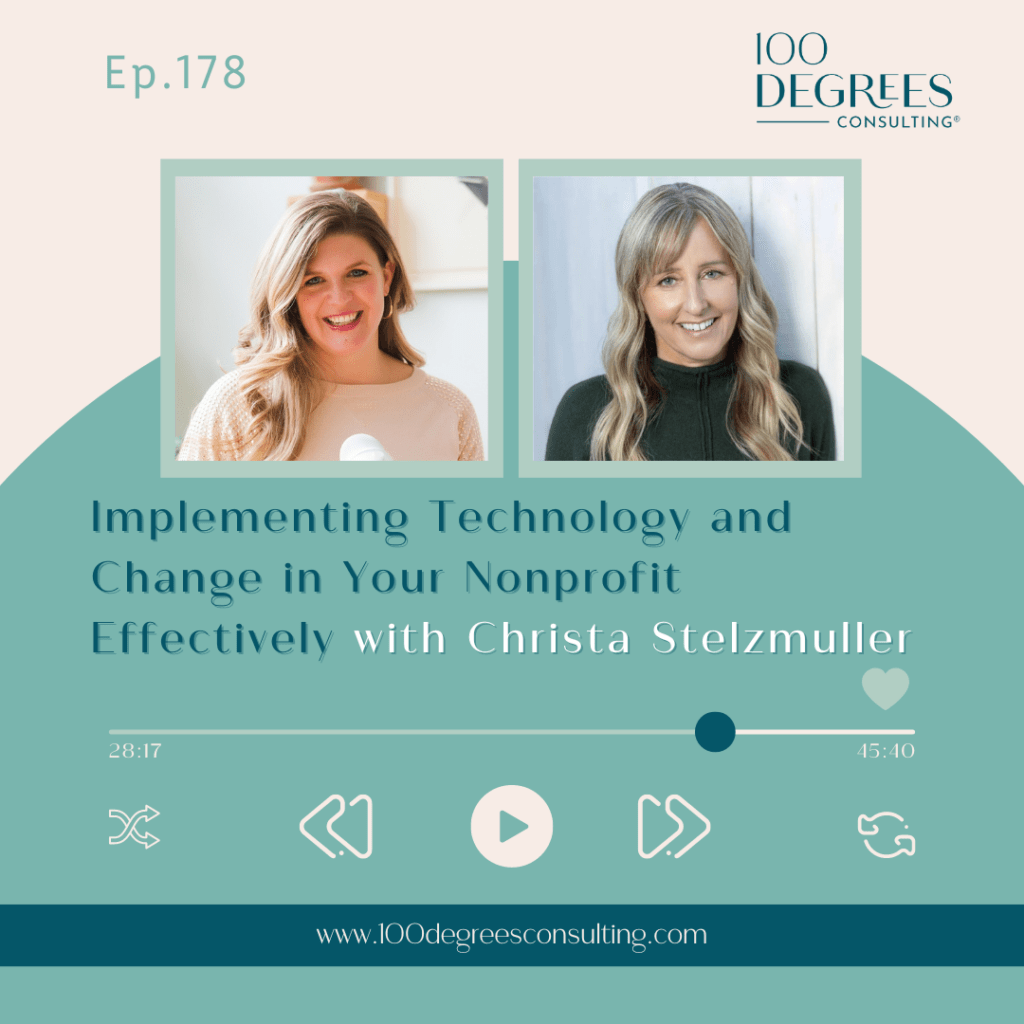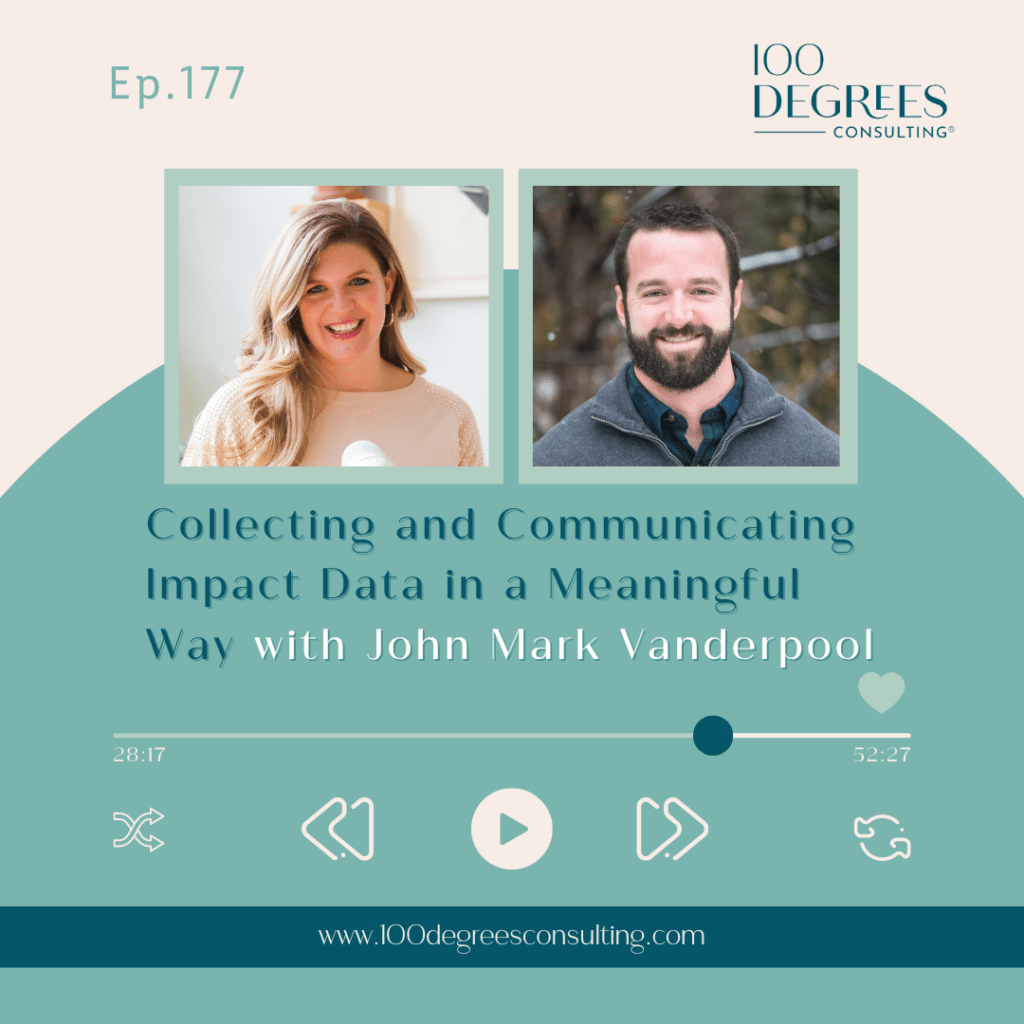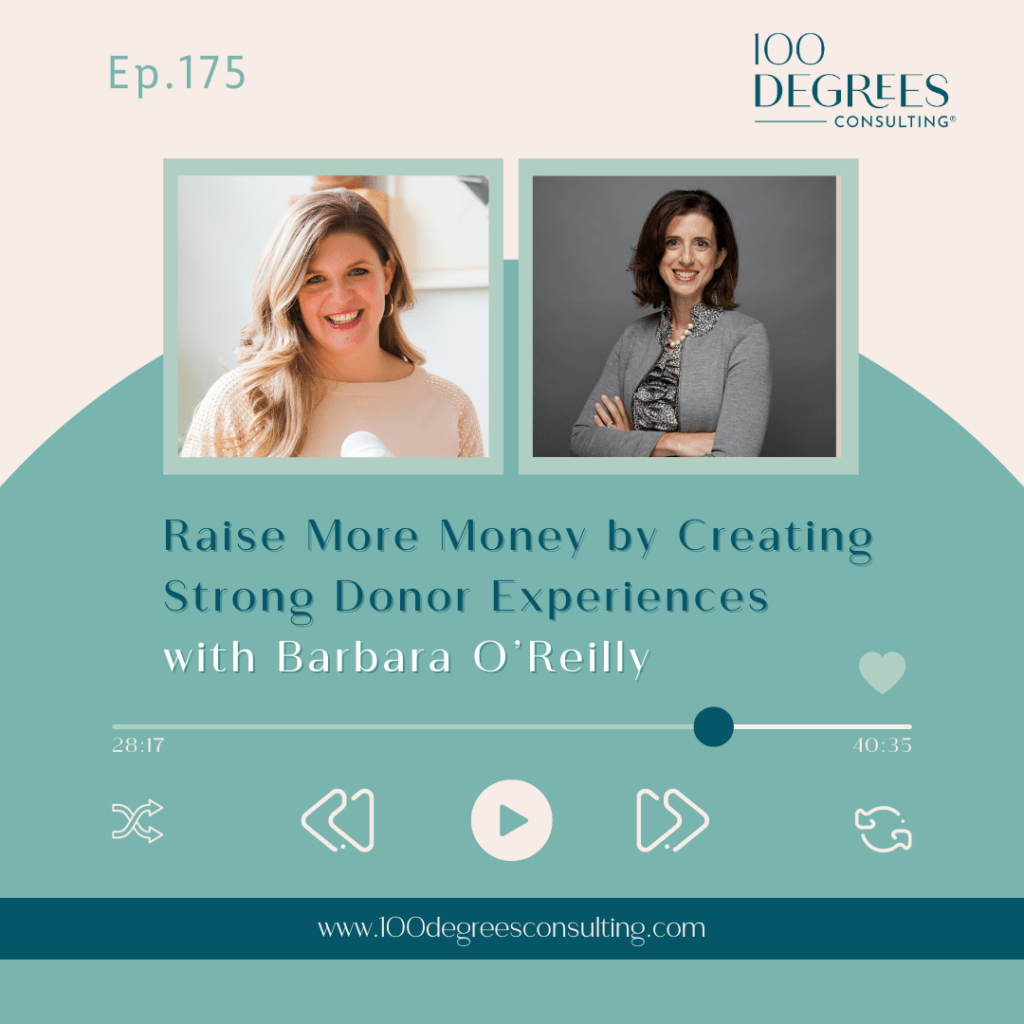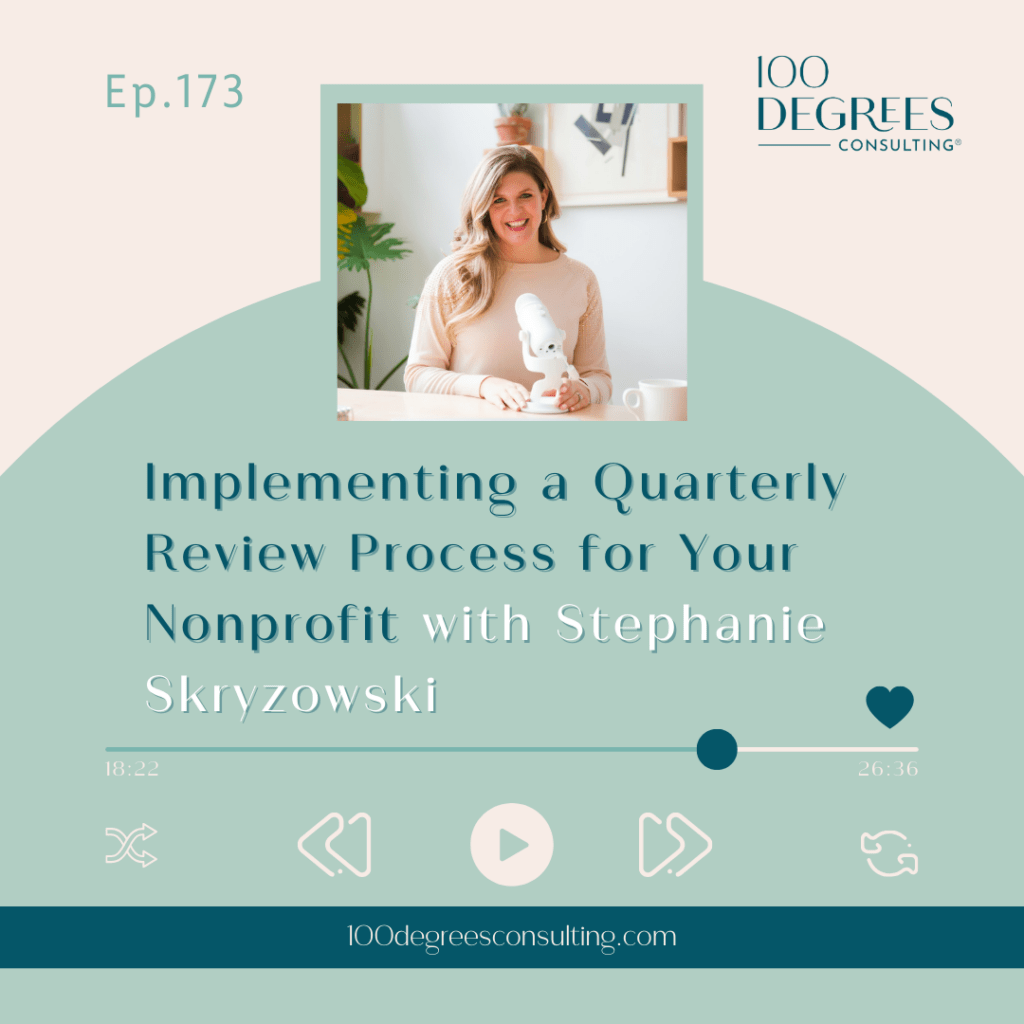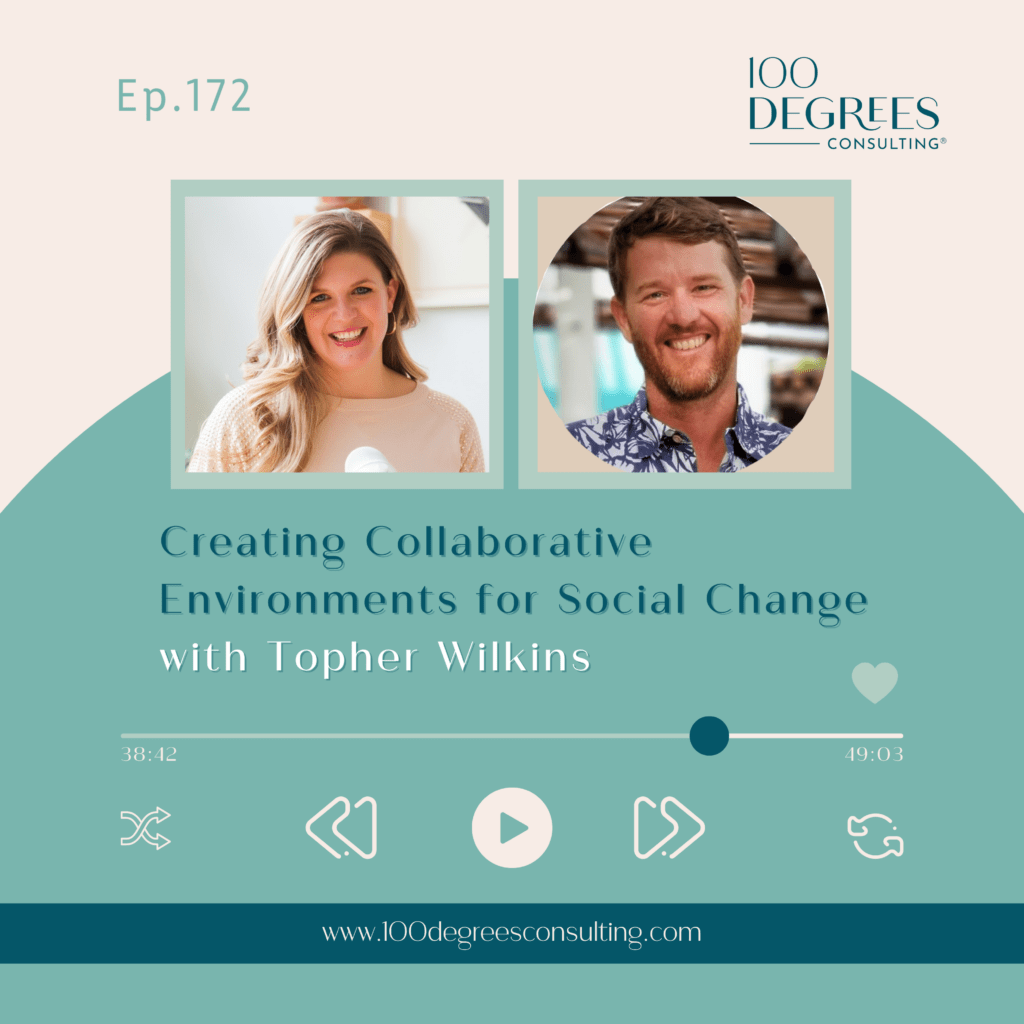Episode 63:
Transcript Episode 63
Stephanie Skryzowski
Welcome to the 100 Degrees of Entrepreneurship podcast the show for purpose driven entrepreneurs who want to get inspired to step outside of your comfort zone. Expand it to your purpose and grow your business in a big way. I’m your host, Stephanie Skryzowski, a globe trotting CFO whose mission is to empower leaders to better understand their numbers to grow their impact and their income. Let’s dive in!
Hello everyone. Welcome back to 100 degrees of entrepreneurship. I’m your host, Stephanie Skryzowski and I’m very excited to have a very special guest on the podcast today. I feel like I probably say that every single episode where I have a guest, but this one is truly special. I have Katherine Binkley on the podcast today. She is my business coach and she’s a business coach for online business owners scaling from six to seven figures.
She has been in the business of growing businesses for over 15 years with the background in marketing and operations consulting. She’s led cross functional high performing teams to scale hundreds of businesses. She started her own business in 2015, and she now coaches and teaches online business owners, how to elevate to CEO, reclaim their freedom and scale to seven. Honestly, I’ve been working with Katherine for the last year and the impact that she has had on my business has been exponential.
(01:26):
If I just think about where we were a year ago and where we are today, a year ago, we were in kind of a tricky place with our team. Now we have 18 full-time team members. Our back end of our different processes and systems and filing and project management and all that stuff was okay. It was like a solid, okay. Now we are in a really, really good place.
In fact, people, when they join our team, they’re like, wow, everything is really organized and really clear on the back end of things, and that is in large part due to Kathryn. So we have a great conversation in store for you today. One of my favorite things that she has helped me with is really to create more space in my life and in my calendar.
And she talks about her exact process for creating more space and freeing up your time in your business and different things that you should be focusing on and not focusing on. So we have a really good conversation. This is kind of like letting you sort of behind the scenes of what Kathryn and I, my business coach, what we’ve worked on for the past year together. So excited to share this conversation with you and I hope you enjoy,
(02:36):
Hey, everybody, welcome back to 100 degrees of entrepreneurship. And I am so excited to have Katherine Binkley on the podcast with me today because Katherine is my business coach and we’ve been working together for a year now. So welcome Katherine.
Kathryn Binkley
Thank you. I’m so excited to be here.
Stephanie Skryzowski (02:54):
Me too. I feel like you have been at the helm of all of the amazing things that have happened in my business in the last 365 days. So I’m so excited to just kind of dig into a little bit more about you and about your experience and the work that you do with clients.
And we can definitely talk a little bit about some of the stuff that you have helped our business with. So first of all, tell us a little bit about who you are and what you do, and the journey of how you got to doing what you do now.
Kathryn Binkley (03:26):
Okay. So right now I’m a business coach for online business owners who are scaling from six to seven figures. Those who are working more than they want to, or just don’t have that feeling of freedom in their schedule and want to are earn more and work less. So they don’t just wanna make more money. They want more freedom
They want more time, and of course they wanna make a bigger impact on the world as well. And they’re ready to stop settling for just one of those three things. Because they know that they can have them all. And so that’s a little bit about what I’m doing. Now, but if we back up, I actually started my career working for full service marketing agencies, and I’ve been working on growing businesses for more than 15 years because that’s what I started my career doing at first, it was through that lens of marketing.
(04:09):
And what was actually really interesting to me is I would notice patterns. I don’t know, I think that’s just like an innate skill set that I have. To see these patterns in things. And so I had clients who were relatively similar and not necessarily always the exact same marketing strategy. But we’d put a strategy in place and some would like take off and really grow their business and others wouldn’t.
And I started to dig in of course, to why that was cause they’re hiring us to grow their business. And what I found was yes, marketing is important, but it was the missing piece of operations behind the scenes that was really slowing others down because as much as they would implement certain strategies, they would get held back either through lack of communication internally or not be able to fulfill the number of clients coming through or just all this red tape.
(05:05):
And so that operation side just started to like be triggered in my mind, I guess you’d say. Then working for full service marketing agencies, I don’t know if anyone else has ever been in the marketing world, but it’s fast paced. It’s important that internally with all of the clients that we worked with, that we had everything really operating like a well-oiled machine.
And so I managed a high performing team. It was a cross-functional team of every type of marketing role that you could need to deliver any marketing strategy to a company that was required. So we had it all covered, but that meant a lot of deadlines and clear communication that needed to happen. And just lots of moving parts and pieces. And so really early on, even though it was through the lens of marketing, there was this background in operations as well.
(05:53):
And then I decided after burning the midnight oil, many, many times for these marketing agencies that I didn’t want to live that way, I didn’t wanna work that way all the time. Now I love to work and I love what I do, but I wanted a little more balance. And so even though I got kudos for staying late and working extra hours, constantly rewarded for that promoted for that, I knew that the only way I could keep earning more in the agency world is if I continued that pace.
And it just wasn’t something that I wanted long term. So I decided to start my own business. I did that back in 2015 and at first it wasn’t done for you services. It was some marketing, then it was some operations. I served as a fractional COO to companies, but I always loved coaching and psychology.
(06:45):
My major in college was actually psychology. I almost became a psychologist. That was one path I’d considered before I shifted gears. It’s funny how much that played into the marketing world, but didn’t go that path, but still always loved that. And someone just happened to tell me, Kathryn, you’d be an incredible business coach. And at the time I was like, what is that?
I mean, I didn’t even have a clue what that meant. I’d been consulting with companies for years at this point to grow their businesses, but I didn’t understand the coaching side of it or that there was this whole online industry tailored to that. And so I started to explore that and research a bit hired my own coach first, just to like dip my toes in the water. What does this even mean? What does this look like?
And pretty quickly I realized I would love this. I would be great at it. I already have the experience needed. And so I just never looked back and shifted to a more scalable business model myself and started teaching everyone, everything from my career about marketing and operations.
Stephanie Skryzowski (07:47):
I love that. That feels like such a natural transition, like just a natural path for you. Were there any points in that journey where you were like, oh my gosh, is this the right decision? Or just like, sort of feeling outside of your comfort zone? Cause it feels like you sort of honed in on your innate skills and the things that you like to do while you were at the agency and then sort of transitioned really naturally into business coaching, but were there any sticky or scary points along the way?
Kathryn Binkley (08:17):
Oh, so many. I can’t even possibly name them all, but I’m a human being just like everyone listening. So I’ve had all the moments of fears and doubt and what I’ll say like one that I’ll highlight that was actually, it has been a pretty big one for me is coming from that agency world. I was used to having a team to implement, I was used to leading and managing a team and now starting my own business.
I wasn’t yet at the place where I could afford to hire team members to do all the different specialty things that were required to grow a business, and so it was all on me. And while I had exposure and kind of knew from that strategy level, what needed to be done, it was very different when it all fell to me.
Not necessarily just from an implementation standpoint of getting it done, although that’s certainly a factor with capacity and prioritizing, but really the mindset behind thinking, okay, I’ve done this for other clients now. Like even the question of why can’t I do this for myself? Or why do doesn’t this feel easy for me because I’ve done this so many times before and yeah, that doesn’t just go away overnight. In fact, I’m not sure it ever goes away.
Stephanie Skryzowski (09:24):
Yeah. I think that’s super, that’s just refreshing to hear that, you know, even someone who’s been in the journey for a really long time been in the game and then have been running your business seven years now, like yeah, we all sort of experience those moments. And one thing I will say, Katherine has a podcast and she recently did an episode that was, I think it was a hundred milestones in your business.
And they were all just little things that you’ve experienced along the way. Some felt negative, you know, some felt like not so great, and some were like super positive, of course too. But if you are a business owner and you’re listening to this podcast and you’re like, oh my gosh, this feels so hard. I feel like I’m the only person. Like I feel so alone. I feel like I’m failing.
(10:04):
I feel like, you know, I’m the only one experiencing these things. Listen to Kathryn’s episode. I listened to the whole thing, all 100 of the things that I was like, yep. Me too, me too, me too, me too. So that’s just, it’s helpful to just kind of bring it back to reality. Like when you’re thinking about it sort of, in retrospect it feels very smooth and natural, but there were lots of little things along the way. So I love that.
Do you feel like now, you know, I know one thing that you talked about and one thing you focus on a lot in your work is helping business owners really have that, the whatever they desire between their personal life and their work. And like you said, you like to work. Do you feel like you have struck that balance that really makes you happy and fulfills you between your work and the rest of your life.
Kathryn Binkley (10:50):
What else is it’s an ongoing process, it’s never done. And so yes and no. Yes, because I’m down to a four day work week for me and my team and that’s incredible. But then there are always weeks whether it’s a launch or whether I’m onboarding a new team member, things that just increase that amount of workload. And it, you know, can be a bit much at times until things calm back down, that’s normal as part of the process.
So I would say for the most part, yes, but I’m not immune to all of these moments or even thinking that I have to do it all. I get really excited about ideas and try to cram in 15 new projects in a single month and it never works, but I still get so excited that I try. And so when those things happen, yeah, I fall into the same challenges. Now, I just have things in place to bring that level of awareness more quickly before it goes too far.
Stephanie Skryzowski (11:46):
I think that last piece is so important because instead of letting yourself just sort of spiral a lot of control, because you’re excited about something or because you just have different things going on, you have a process or a framework to be able to ask yourself questions. Okay. You know, should I be doing this? It’s the right time, whatever. That’s something you’ve really, really helped me with over the last year.
Because I have come to you, you know, telling you over and over again, I’m too busy. I can’t do this, I can’t do that, I wanna make time for this, I don’t have space for this. I’m feeling like kind of negative about my business because I’m just working so much, blah, blah, blah. And you have really helped me create more space in my work, you know, in my work week and in my life.
And I feel like, like you said, it’s a process. We’re not entirely there yet, but I feel like I’ve made huge strides. But I was wondering if you could talk a little bit about your process too. For business owners to create space, to free up more of their time. What does that look like? Is it just like, tell us what that looks like.
Kathryn Binkley (12:50):
Yeah, absolutely. So business owners come to me and there’s spending their time doing all kinds of things, some things moving the needle forward. Some not some things that they really enjoy. Some things that they don’t. And so one of the first things I like to do is really get a good understanding of how they’re spending their time currently, like what their current situation is and also what their ideal schedule is.
Once I have those two pieces, there are typically five different strategies that we use to start to create more space and move them from where they are now to what that ideal schedule looks like. And so I can just talk through each of those quickly, I actually use the acronym space. So that may be helpful for everyone to remember.
First is systemized, so it’s taking the things that you’re doing and documenting the processes. C reating a clear process in some case, if you don’t have it, but then documenting that.
(13:39):
And that makes it easy for either you to do more efficiently because you’re not trying to remember, okay, wait, how did I do this last time? Because you have it documented or it makes it very simple to hand off. And we’ll talk about that strategy in a moment as well. Next up is protecting your time. And that’s all about putting the right boundaries in place.
This comes back to what’s really important to you from a values and priority standpoint, and then using those boundaries to protect that time by saying, this is how I work with clients, this is when I work, this is when I don’t work. If someone does this, then here’s how I’m going to respond and I can give a couple of examples to make this more tangible.
It’s as simple as something like I never ever have a challenge attending my kids’ sports activities at the end of the day. Even though they overlap with a typical work day, because at the beginning of the, every season, my executive assistant puts all of those appointments on my calendar and no one can schedule anything over the top of those.
(14:43):
And that’s just a boundary of set or another example, may be I tell my clients, you can contact me anytime you want, but here’s when I will reply. It’s going to be Monday through Thursday, eight to five Eastern time. That’s my standard response time. If I decide to reply outside of that, that’s up to me, but I’m the one to maintain that boundary. And I communicate that up front.
So those are a couple of ways that I protect my time and there are many, many more. Next up is automate. If you really think through the journey that your clients go through from the buyer journey, all the way through becoming a customer to delivering and look at all the things that have to happen.
There are so many opportunities to automate things so that you don’t have to do them manually. Oftentimes that involves some software or some tools, but you’ll find that the return on investment is almost always there.
(15:34):
If it’s something that’s happening frequently. So looking for those opportunities to automate. Then you want to cut out anything that isn’t actually moving the needle forward. A lot of this has to do with just simplifying your business model. It is really honing in on the couple of strategies that are helping you get results and making the biggest impact while requiring the least amount of effort and then cutting out the rest.
And then last is interest and that’s all about delegating. So once you’ve systemized something or you’ve set a boundary, you’ve gone through these other steps, there’s still things that need to be done. And if it’s not something that really lights you up, that gives you energy, that you’re excited about, then you can hire and delegate to get that off of your plate.
Stephanie Skryzowski (16:18):
I feel like I didn’t know that you had this amazing acronym called space for freeing, you know, creating more space. But you definitely walked me through this entire process. And one thing that I realized that in our work together, that I almost didn’t realize I had the power to define what I wanted my week to look like. I don’t know if I knew what I wanted my week to look like, because I had never taken the time to go through that exercise.
I just knew that what was current was not working, but I didn’t actually ever go through that process of defining what I wanted it to look like. So, you know, if anybody’s listening, you’re like, oh my gosh, my calendar’s a hot mess. Like, have you ever actually sat down and really put words, like put it down on paper, what you want your week to look like?
(17:03):
And you had me do that just even again at the beginning of this year. Then I kind of didn’t realize that I had the power to set boundaries in my calendar. And so now, I feel like this year has been, I think there’s still too much on my calendar.
There’s still too much on my plate, but I feel like I have so much more control because I have set boundaries on when I take meetings and which days I don’t take meetings, what time I reserve to actually get work done and the types of meetings I take on which days and things like that. And you really helped me put those boundaries in place and protect my time.
And I almost didn’t, it sounds so silly, but I almost didn’t realize that I even could do that. Is that weird? Do you see that with your clients? I’m like, I didn’t realize I could. I don’t know. I just didn’t really even think about it that way.
Kathryn Binkley (17:51):
Yeah. I think so often we think that, or we just allow unintentionally our schedules to dictate themselves. We just say yes to things, or we think that they’re important and they have to happen. And our schedules just create themselves versus us taking really stepping into that ownership role, that CEO role and saying, no, this is what I want my schedule to look like.
These are the most important things to me. This is what I should be spending my time on and really blocking the time to do so. And then creating rules around everything else.
Stephanie Skryzowski (18:25):
Yeah. That has definitely been me for the first five years of running my company is that I just basically let my schedule be what it would be. And then I’m like, wait, why am I so miserable? Oh, because I have no control over my schedule whatsoever. So yeah, that’s been a huge, huge game changer for me.
(18:47):
Hey, friends! Are you feeling stuck with what to do next to manage the money in your business? Maybe you’ve logged in to QuickBooks once or twice, but got instantly overwhelmed, maybe you started to set revenue goals, but don’t know where to go from here. Maybe you simply know that managing your numbers is the right thing to do. But you don’t know what that actually means. I’ve got you covered. I have a brand new 10 step checklist to manage your business like a CFO, without making it your full time job. Head over to 100degreesconsulting.com/checklists to get the free checklist.
(19:22):
The other thing I’m thinking about is cutting as part of the sea in your acronym space. Cutting what is not moving the needle. How do you help business owners or how have you figured out in your own business, what to cut? Like how do you know if the needle is moving or not and how to make that decision?
Because sometimes it feels like, okay, I think I’m getting a bunch of likes on Instagram. Like, I feel like I should be putting time towards, you know, writing these amazing captions or creating reels, but like, how do you know when something is moving the needle?
Kathryn Binkley (19:54):
Yeah. Such a good question. And I’m gonna answer it in two ways. First, the simple way that I can explain this that most CEOs really latch onto is doing an impact versus effort analysis. And I like to create a quadrant of high impact, low impact, and then low effort, high effort, and just map things out, where do they fall? Is this something that requires a lot of effort?
Meaning my or my team’s time resources, whether money, energy, whatever, so higher, low effort. And then is it making a big impact or not towards the goal? If you have a question for that impact piece to dig in, then it all comes down to numbers. And I know you love numbers, so we’ll just chat about that for a second.
But first on that impact versus effort analysis, if something is high impact and low effort, do more of it, like double down, that’s where you should be spending your time. Because that means there’s a high return on investment.
(20:49):
If something is low impact and high effort, cut it out as quick as you can or see how you can make it more efficient or more effective, one or the other. And you can use some of the strategies I talked about before. Like if you put a system around it now, is it more efficient and therefore requiring less effort? So you can try to move it into another quadrant.
Otherwise, if you can’t move it, cut it. Everything kind of in the middle, you wanna again, look at how you can make it more efficient or effective. And so getting back to the core of your question around effectiveness and how you really know if something’s impactful, you’ve gotta look at your numbers. And for me, that’s both financials and key performance indicators. We have a company scorecard that we look at. For with a few metrics that I like to look at for the entire company.
(21:35):
But then we also have a scorecard with KPIs for each department. I have a small business, by the way, like I’m not a huge business. And I wanna say that because when I start talking about departments and company, like a lot of people are scared by that. Or it makes them think that you have to be really big before you start talking in terms like that.
Even if you’re a solopreneur, I recommend you start thinking about your business in those three core departments or functions, growth marketing and sales operations, which is kind of the back end and then client success. So growth marketing and sales. In other words, all about getting customers client success, serving them operations, all the back end stuff.
But when you think about each of those departments and you have scorecards with certain KPIs for what success looks like inside of that department, and you just keep tabs on that weekly, then that’s how I know if something’s effective or not. We look at the baseline, we set a goal and we track it every single week to know where we stand.
Stephanie Skryzowski (22:29):
Yeah. That’s super helpful. Could you give a couple examples of some of the things that you’re tracking in one of your departments?
Kathryn Binkley (22:37):
Yeah, absolutely. I will say I do love numbers. And so I have a lot of numbers that I like to look at, but I really encourage you to keep it simple. It could be very like for growth. Let’s just talk about marketing and sales. When you think about the buyer journey, you, and even from your standpoint, a simple growth strategy, you need to be getting visible.
You need to be giving them an opportunity to opt in and generate a what I would call like a marketing qualified lead. You need to nurture them, then turn them into a sales qualified lead if they’re actually interested in working with you, and then of course sales. And so if you look at those five key areas of the journey, whether from your view or a client view, then you’ll have a number for each. So for visibility. It’s how many people are you reaching?
(23:26):
For marketing qualified leads is how many people are opting into your email list. As one example for nurturing, it might be the number of it depends on the channel you’re using for nurturing, but for us, if it’s the podcast, it’s how many downloads we’re getting on the podcast. For sales qualified leads, it could be the number of consults or sales calls booked.
And then of course, sales, the number of sales actually booked. You could look at the conversion rates in between all of those to get a little more complex and to see where you could start to optimize or improve things. But at a core, if you just had the five key numbers with one simple strategy for each that you’re using, you could start to move the needle forward.
Stephanie Skryzowski (24:03):
I like that. I mean I like numbers too, but even I’ve gotten tripped up by what KPIs for other, anything outside of the financials. Like I know what I need to look at for the financials, but anything outside of that, I always get tripped up with like, should I be looking at Instagram followers or like comments? Like I don’t know what to look at. But I love how you just broke that down between really thinking about your customer journey and the different pieces along the way.
And those are the numbers that you need to look at. If Instagram is not part of your strategy, then why are we tracking Instagram followers? It’s not, you know, it’s not significant. That’s not moving the needle. So I like that. How you broke that down because yeah, like I said, KPIs related to anything outside of financials have always been a little bit tricky for me, cause I’m just like, I’m just not entirely sure what to track.
(24:50):
So I love the way you broke that down. And I do know that that is something that you and I will be working on together in the very near future for my business. We’ve had lots of other priorities over the last year. So we’ll definitely be working on that. I wanted to just go back to what you had said about the idea of departments and for anybody listening, who, if you’re like, it’s literally just me or it’s just me and a virtual assistant.
I was the same way. Like, honestly, Kathryn, when you initially were like, let’s think about your business in terms of departments. I’m like, there are no departments, right? It’s like the people that are serving our clients and me, like, that’s pretty much the departments, but you had me create org chart, an actual hierarchy org chart, a traditional looking org chart.
(25:32):
You can picture in your head and list out all of the different positions in the company and put people’s names to it. And you’re like, even if your name is on 10 different roles, that’s okay. But we need to be able to visualize what the company structure looks like. And I found that so helpful. It almost validated, it almost gave me this sort of feeling of legitimacy as a real company, even though do I have a growth department?
No, I don’t. It’s me. It’s me in all those roles, Stephanie is listed for like seven different things, but it actually was a really helpful to be able to start thinking a little bit differently about the business and about priorities for each of those specific departments. Even if it is a department of one myself or a department of me and one other person on my team.
(26:22):
So I would just say like, yeah, like Katherine said, if you have a small business and you’re like, I don’t have department, you actually do. It’s probably just you doing all of those things and that exercise. We keep that org chart updated. Like every time we add somebody new or every time a role within our company shifts, and maybe I’m not doing something anymore, but somebody else is we’re shifting that around all the time.
It’s very helpful to have like a 30,000 foot view of the company in that way. And I just never thought about it like that before. So that was something that you really helped us with.
Kathryn Binkley (26:54):
Yeah. It’s one of the things I love to have in place for a couple of reasons. And a lot of what you just said is why it’s so important. I’ll add that. It’s not just to organize people, it’s to organize everything in your business. From all of the work and the projects to the files when you’re organizing them, wherever you store all of your files to systems to your numbers.
Like I said, we have scorecards for each department. So everything in the business is organized that way. And the reason why at the core is because then it’s scalable. All of those things become scalable because there’s a different structure to it that can grow with your company no matter how large it gets.
But then beyond that, I think it just helps for CEOs, especially even if you don’t really relate yet to that title of CEO, if you’re a business owner, it helps you see you’re doing that’s truly in that CEO role versus what you’re doing that is just part of another role in the company that eventually you need to replace yourself in that space.
(27:53):
I’ve had business owners who just thought that this was a natural piece of what they had to do. And then realized that was an entire department that they had a blind spot for. They didn’t even understand that that was a whole department of people that they will have one day in their company and thought it was just their responsibility. And so it really helps to clear that up and give you a path to really elevate to that CEO role.
Stephanie Skryzowski (28:16):
A hundred percent. It really helped me also like have a greater vision for my company when I was on your podcast. We recorded it a few weeks ago. We had talked about a conversation that we had had maybe I feel like it was a year ago, but maybe it wasn’t, maybe it was less than that. Where I had decided in my head, I had set an totally arbitrary limit on my business.
I had said, okay, I think I can grow to about a million dollars in revenue. I think I’m gonna have to stop then. Like, I think that’s all I can handle. And you’re like, why , why do you have to stop at a million dollars? I’m like, I don’t know, cause I don’t think I can do more than that. Like I don’t think I want to manage the team and like support a business it’s any more than that.
(28:58):
And you basically in, I feel like the org chart was part of it. We were able to kind of come up with a plan where we sort of uncovered formula for really endless growth. You helped me figure out a formula, like, okay, this number of clients to this, you know, this sort of staffing model and we can just keep stacking on top of each other and building out that org chart really helps me to see that.
And now, yeah, I now I don’t believe that there’s some invisible cap on my revenue or on my business or on the growth. So that was really cool. And I never would’ve thought that an org chart and a conversation around that would lead to me really thinking through new possibilities. So I just, I love that.
I was gonna ask you what’s been a really big transformation or a favorite transformation that you’ve seen in one of your clients. Like I know you’ve worked with some clients for like several years, right? Like I would love to just to hear a before and after of a favorite client or a favorite experience.
Kathryn Binkley (30:01):
Yeah. I’ll tell a story from one of my clients. When I came on board, they were around the 400K mark in their business and everything was chaos, to put it nicely. And I know that they would agree there was no organization, they were overstaffed. They had way too many team members with over a lapping responsibilities.
And the profit margins were really either declining or just non-existent even some months because they were investing so much into growth, but it wasn’t paying off yet just yeah, unclear roles so much on the back end that needed to be addressed.
And really, we tackled a lot of it in about four months and they, I remember said like our business looks completely different just four months into working with you. But my favorite moment I think came even a bit later, they didn’t have our project management system that they were using like so many things that we put into place.
(30:56):
And even as we started to use a project management system at first, it was kind of overwhelming because the CEO still had a long list of tasks that she needed to tackle. And a lot of things were overdue a lot of the time. So she was used to working nights and weekends. And there was a moment where she came to me and she said, this weekend, I was sitting at my dining room table with my husband.
I looked across the table and I actually said to him, I have nothing that has to be done this weekend. I have nothing overdue in my project management system. Even if I wanted to work, it’s all taken care of. I have the team who’s handling things and the certain things are off of her plate now. And I just have nothing that needs to be done.
(31:39):
Like this is the first time in a long time, I’ve fully felt free and literally had nothing to do. And for me that was such a big moment that, I mean, it’s kind of like a proud mom moment, even though she’s a client, like I have those moments and I was just so excited to hear that for her and so excited for her because as a visionary, especially as someone who, you know, is really focused on the future, she had been so caught in the weeds of her business and the overdue tasks and the things that had to get done right now that for so long, she wasn’t really looking bigger picture looking ahead.
She finally said, I have the space to now look forward. And so they got super close to 1 million. Didn’t quite cross the mark, although they may be there now with a rolling 12 month view. And she said, but I’m not focused on 1 million anymore, like that’s done in my mind. Like we’re gonna cross that. I’m looking at 10 million. And so I just love that she’s spending her time dreaming and focused on what a visionary truly should be doing as the CEO of the company.
Stephanie Skryzowski (32:42):
Oh my gosh. I love that so much. And I was like, wait a second. Is she talking about me? Like, just not naming names, like, wait, cause that sounds very familiar that entire journey. I won’t say our back end was chaos, chaos, but we’ve made some very big strides since we started working with you a year ago. But that whole story sounds very familiar to me.
Yeah. meaning it feels like my story. So I love that. That’s like, there’s just something to be said for, and you and I have even talked about this. I’m like, what do I do in the evenings when I’m not working? Like what I literally don’t know what to do with myself. I cannot watch the office another time.
Like I just can’t. And so we’ve literally had boxer conversations like Katherine help, I don’t know what to do with myself. So I think that that is, that’s a good conversation to have. That’s a very good conversation to have.
Kathryn Binkley (33:40):
Yeah, absolutely. And no, that, wasn’t your story. Although I know you can certainly relate. I love that. I have lots of those stories that kind of go that path, but that was just one in particular. When you’re thinking about what to do at night, or really anytime I wanna touch on that for a second, because a lot of the CEOs I work with are like, wait, if I free up all this time, if I systemize, if I protect, automate, cut, and trust everything we went through and I hand off all of this stuff, what am I supposed to do?
And just a reminder, CEO is an entire job in and of itself. Like, that’s a whole job that someone is supposed to be doing. And many of you are ignoring the responsibilities of a CEO to stay in the weeds and do other things.
(34:23):
Now you can do whatever you want to do. It’s okay. If you love a certain aspect of the business and you wanna stay in the weeds, but let’s not forget that actually is an entire role and there’s no need to feel bad or to feel guilty for sitting and thinking. A lot of my clients say to me like, but just thinking like that’s not productive.
And I’m like, no, that’s exactly what we need you to be doing to move the business forward. Because you’re the visionary, this is your brain that we need to tap into. We need you to be coming up with more ideas. So don’t feel guilty about that stuff and know that that’s part of your job.
Stephanie Skryzowski (34:54):
I feel guilty for thinking time. I definitely, I’m working on it. I’m working on it with you. It’s hard though. It’s very hard, especially when you’re just used to being in that go go go mode where you’re checking things off the list. And that is what makes you feel accomplished and productive. And I’m learning, but yeah, that can be very difficult. But just as encouragement to anybody who is listening, that’s like, yeah, that’s me.
I can’t just sit still. It’s a practice, it’s something that I have been actively practicing. And yeah, when I get my head space, right? It feels amazing. And that’s my goal now is to have more light space, more thinking space because it’s impossible to come up with the next big idea for your business to get you from 1 million to 10 million in the 30 minute window in between zoom calls. Like that’s literally impossible.
And so that’s something I’m working on too, I love that story. I wanna ask you before we wrap up, I wanna ask you, how do you manage your numbers in your business? I know you’re a numbers person, but yeah. What’s your, like, how do you look at your numbers? How do you think about your numbers? What does your numbers, finance routine look like? How do you manage your numbers?
Kathryn Binkley (36:05):
Yeah, such a good question. So I’ll tackle this from both ends first, the KPIs, which I already touched on so I’ll keep this piece quick. And I have a team member who every single Monday morning updates the scorecards for each and every department. And we look at those in our department meetings every single week. So we’re just keeping our finger on the pulse of those key performance indicators for each department weekly.
And so that’s just part of that routine. Then from a financial aspect, I actually have a bookkeeper on staff who does all of the lower level bookkeeping work to make sure that we’re looking, you know, everything’s tracked properly, categorized properly, all of that. And then we look at a financial forecast just like Stephanie would recommend that’s important to not just look at the past, but look ahead. So we look at that on a monthly basis, we have a finance meeting every single month.
(36:58):
I mean, I think that at this point, so much of it is systemized that I don’t have to do a lot during the month. My team takes care of categorizing everything, pulling receipts to make sure we’ve got those on file. Then I just show up to finance meeting once a month, then I’ve got reports ready to go to look at and make decisions based on anytime I need numbers outside of that, I’ll just ask for them.
And so, yeah, I can’t imagine not having those numbers. I know this is, you know, Stephanie’s podcast here, so she’s probably talked about it before, but if you don’t have that in place, definitely talk to Stephanie to get that routine in place because you need those numbers.
Stephanie Skryzowski (37:37):
I love how easily you just talked about that. You’re like, yep, we just do this and we just do that and blah, blah, blah. And you talked about that so easily because it’s part of your routine and you stay on top of it and it’s not something that you let slip or let you know, fall behind. So it doesn’t feel hard. It sounds like it feels pretty easy and straightforward because you have the right tools and the right process.
You have the right people in place to help you with all of that. And I love it. You were just like, yep, we do this and we do this and boom, we can make our decisions. And that’s how it should be, that’s how it can be. That’s how it is for people that have this routine and the processes and the systems and the people in place.
So I love that, you just made that sound very easy. And so just like shameless plug for our services, of course we can help you feel as easy as Katherine does about her numbers. Okay. So I just have two more questions that I like to ask at the very end. So my first one is what helps you disconnect from work?
Kathryn Binkley (38:36):
For me, it comes back to systems and boundaries and just blocking Fridays off, certainly helps because my team doesn’t schedule anything for me to do and I don’t accept meetings. So every single Friday automatically I don’t have anything that has to be done. And that’s like, I guess, more on a systems basis or just a boundary of nothing scheduled for me to do.
But then sometimes there’s a difference in having time off and then actually feeling free. And so the other piece of that I think is trying to plan something for myself to do on those days, not just sitting, cause if I just sit and don’t have anything to do, my mind is gonna go back to work.
I’m gonna think about things, so I just to try to plan something fun or something simple, whether it’s, you know, going to get a massage or going out for dinner or not dinner, but lunch during the day, going for a walk, getting outside anytime I can just get away from the computer and change up my environment. I think that’s what helps the most.
Stephanie Skryzowski (39:34):
Yeah. I love that. I love that you intentionally plan something for your day off. Otherwise default mode is gonna be back to working and then you haven’t actually really disconnected at all. I think that’s yeah, very smart. And my second question is what is the best book that you have read recently? You’ve given me tons of good book recommendations over the last year. So I don’t know if you have a good one that you’ve read recently.
Kathryn Binkley (39:57):
Absolutely love to read and I read a lot, so let me just browse my library really quickly. My library.
Stephanie Skryzowski (40:08):
I just did the same thing.
Kathryn Binkley (40:09):
Yeah. Yeah. There are so many I could probably spout off a 10, but if you haven’t read the book
(40:16):
$100M Offers by Alex Hormozi, that’s a really good one that I read recently. Some of the things in there, of course, some of the basic things that are great reminders. But then some of it like it’s the basics that’s gonna really help you have an irresistible offer. And I thought that was a really good refresher on offers and making those irresistible. And then if I went back to my favorite all time book and not just recently, I would say the book Drive by Daniel Pink is one of my absolute favorites.
He talks about the three things that are our drivers as humans, the things that actually motivate us. And I have read this book through the lens of marketing. I’ve read this book through the lens of managing a team and what is required to motivate people in a team setting and either way, whether it’s from a marketing perspective or a leadership perspective, it’s very, very beneficial.
And you’ll see, it’s not really all about holding a carrot in front of someone with the idea of a promotion or a raise or money. That’s not the biggest motivators for people. And so yeah, definitely recommend that book.
Stephanie Skryzowski (41:26):
Ooh, I have not read that one. I have read $100M Offers and I like flew through it cause it’s a very easy read. I feel like I need to go back through it again and just dig a little deeper and somebody actually gave me, I have it up there.
There’s a workbook that goes along with it that I don’t, I guess you could, I haven’t even opened it. I think you can fill in. So maybe I’ll go back through and read that. That is a really good book though. I agree. And now I am placing a hold at my library for drive, so I’ll definitely read. Thank you.
Kathryn Binkley (41:53):
You’re welcome.
Stephanie Skryzowski (41:54):
Well, Kathryn, it was a joy to talk to you today as always. You’ve been such a support for me personally and professionally and my company over the last year. And I’m just so grateful for our time together over the last year, but also in the last 45 minutes. So Kathryn, where can our listeners find you, connect with you and learn more about the work that you do?
Kathryn Binkley (42:17):
Well, you could for sure go listen to my podcast, it’s called scale to seven. So just search for the scale to seven podcast, you can find me on Instagram. And otherwise, I also will say that there’s a seven figure scalability quiz that my team and I have put together that you can go check out if you just go to kathrynbinkley.com right on the homepage, there will be a link to that and you can find out what’s holding you back from seven figures and what to focus on next to get there.
Stephanie Skryzowski (42:45):
Ooh, cool. I’m gonna go take your quiz. Awesome. Well thank you again, Kathryn. Thanks for being here. I appreciate you.
Kathryn Binkley (42:51):
Thank you.
Stephanie Skryzowski (42:54):
Thanks for listening to the 100 degrees of entrepreneurship podcast. To access our show notes and bonus content, visit 100degreesconsulting.com/podcast. Make sure to snap a screenshot on your phone of this episode and tag me on Instagram @stephanie.skry and I’ll be sure to share thanks for being here friends and I’ll see you next time.
Transcript for Episode 63


